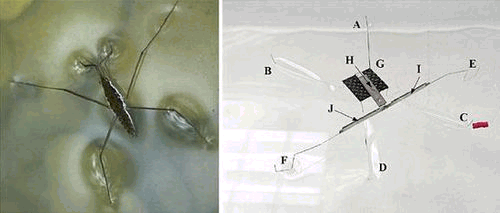July 11, 2007 feature
Robot walks on water

Water striders, insects that walk on the surface of the water, may never set foot on land in their lives, and yet they’re not swimmers. Over the past million or so years, this insect—sometimes called a water skater—has optimized its use of surface tension to balance its 0.01-gram body on lakes, ponds, and even oceans.
Researchers Yun Seong Song, a PhD student in mechanical engineering, and Metin Sitti, assistant professor in mechanical engineering, both from Carnegie Mellon University, have recently built a robot that mimics the water strider’s natural abilities. The first water striding robot, with an appearance and design closely resembling its insect counterpart, doesn’t ever break the surface tension of the water, and is highly maneuverable.
Song and Sitti’s small robot is different from other floating robots in that its small mass and long legs enable it to utilize the surface tension force to stay afloat. In contrast, macroscale bodies must rely on buoyancy, which is based on their large volumes. The researchers predict that such a robot might be used for environmental monitoring via wireless communication, as well as for educational and entertainment purposes.
“Water strider robots—we call them STRIDEs (Surface Tension Robotic Insect Dynamic Explorer)—can walk on water only 3-4 mm deep (shallow water),” Sitti explained to ������ƵOrg.com. “Their power efficiency and agility (speed and maneuverability) are much superior for relatively small water vehicles since the STRIDE legs have much less drag than any buoyancy based robot.”
Of course, as Sitti explained, this advantage is eliminated when the STRIDE becomes meter-scale, since surface tension force scaling is not favorable at large scales.
From models and calculations, the researchers found that an optimal robot would have hydrophobic wire legs coated with Teflon, each 5 cm long. Twelve of these legs attached to the 1-gram body of the robot could support a payload of up to 9.3 grams in their experiments. The key to avoiding the breaking of the water surface is in maintaining a water-air interface that is more horizontal than vertical.
For locomotion, the water strider insect creates a sculling motion with specialized sculling legs. The robot functions the same way. Three piezoelectric actuators, when attached to the legs in a T shape, create both vertical and horizontal motion to cause the elliptical sculling motion required to move.
Because the piezoelectric actuators provided only a small deflection, an amplifier was needed to create large strokes. To achieve this, the researchers used a resonant frequency with a vibration mode favorable to generating the sculling motion to drive the actuators. While a water strider insect can move at speeds of up to 1.5 m/s, the first robot still achieved a forward speed of 3 cm/s, and could also turn, rotate and move backwards.
Currently, rough water may present a hazard to the robot striders. However, Sitti hoped that by improving the lift capability and water sealing of the current STRIDE, the robot would be able to withstand waves and storms.
Song and Sitti are working on other ways to improve the robot in future prototypes. For example, the T-shape actuator mechanism accounts for more than half the weight of the robot, which could possibly be hindering the robot’s speed.
In a more recent prototype, for instance, the researchers designed a STRIDE that used two battery-powered micromotors to walk on water. Although this set-up had an increased mass of 6 grams, the robot also achieved an increased speed of 8.7 cm/s. The group plans to continue experimenting with different options.
“STRIDE is 10-15 times slower than the insect, since the current prototype is almost 10 times larger than the insect,” Sitti explained. “Therefore, we would miniaturize the STRIDE more. Moreover, we are integrating wireless communication, sensors, and teleoperated and autonomous control capability to the new STRIDE prototypes. Thus, we could deploy tens or hundreds of these robots to the water surface for environment monitoring.”
Citation: Song, Yun Seong, and Sitti, Metin. “Surface-Tension-Driven Biologically Inspired Water Strider Robots: Theory and Experiments.” IEEE Transactions on Robotics, Vol. 23, No. 3, June 2007.
Copyright 2007 ������ƵOrg.com.
All rights reserved. This material may not be published, broadcast, rewritten or redistributed in whole or part without the express written permission of ������ƵOrg.com.





















